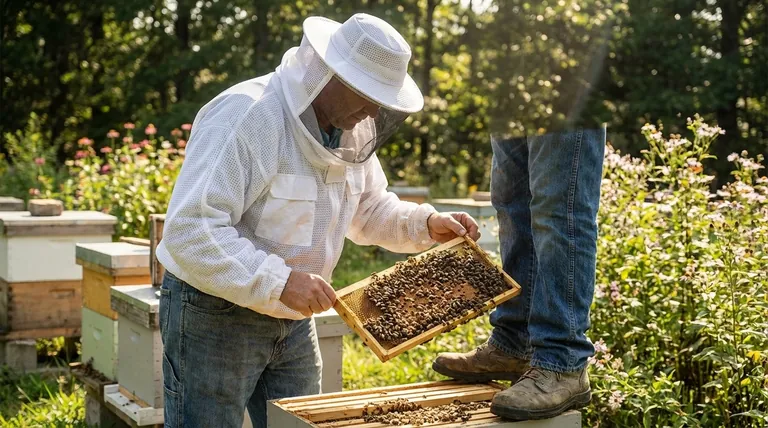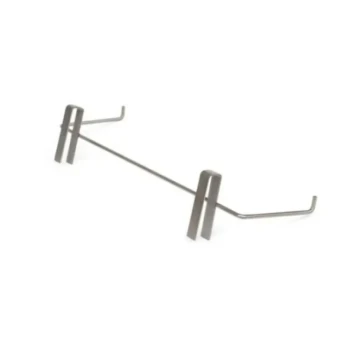At its core, a beekeeping jacket with an integrated hat veil is recommended because it provides targeted, essential protection where you need it most. Bees are biologically wired to perceive your face as the primary threat, and they are drawn to the carbon dioxide you exhale. This piece of equipment directly counters that instinct by shielding your head, face, and neck while securing your upper body.
The jacket and veil combination strikes a crucial balance: it delivers non-negotiable protection for your most vulnerable area—the face—while offering far greater comfort, ventilation, and mobility than a cumbersome full suit.

The Core Reason: Understanding Bee Behavior
To choose the right gear, you first need to understand the threat you are managing. A bee's defensive response is not random; it is a predictable reaction to specific triggers.
Bees Target the Face and Head
Guard bees are programmed to defend the hive by attacking an intruder's most vulnerable points. In mammals, this is the face and head region, which they instinctively target. A veil physically blocks this primary attack vector.
Carbon Dioxide is a Trigger
Bees can detect the carbon dioxide (CO2) you exhale. An increase in CO2, such as from nervous or heavy breathing, signals a potential threat and can trigger an aggressive defensive response. A veil creates a barrier that helps disperse your breath and keep bees away from your mouth and nose.
A Secure Seal is Critical
A simple hat and veil worn over a shirt can leave gaps. A bee that gets inside your veil is significantly more dangerous and disorienting than one on the outside. An integrated jacket features an elastic waistline and secure wrists, preventing bees from crawling up your torso and into the veil from below.
Practical Advantages of a Jacket and Veil
Compared to the alternatives—a full suit or just a standalone veil—the jacket combo offers a compelling middle ground for most beekeepers.
Superior Ventilation and Mobility
A full beekeeping suit can be extremely hot and restrictive, leading to fatigue and overheating during hive inspections. A jacket provides essential upper-body protection while allowing for significantly more airflow and freedom of movement, making the work more comfortable and sustainable.
Ease of Use for Most Beekeepers
For the hobbyist or sideline beekeeper performing regular, less intensive inspections, a jacket is far more practical than a full suit. It's faster to put on and take off, making it ideal for quick checks in controlled environments.
Integrated and Reliable Protection
The all-in-one design of a jacket and veil ensures there are no accidental gaps between your head covering and torso protection. The veil is made of high-visibility mesh that keeps insects out without significantly obstructing your view of the hive.
Understanding the Trade-offs
While highly effective, a jacket and veil is not a complete solution. Being aware of its limitations is key to using it safely.
No Lower Body Protection
The most obvious trade-off is the lack of protection for your legs and feet. Bees can and will sting uncovered ankles or legs. You must supplement the jacket by wearing thick pants (like heavy denim jeans, never leggings) and closed-toed boots that cover your ankles.
Not Ideal for Aggressive Hives
If you are working with an unknown colony, performing a complex removal, or managing a known "hot" or aggressive hive, the comprehensive security of a full suit is the safer choice. A jacket leaves your lower body as a potential target for a large-scale defensive response.
Making the Right Choice for Your Goal
Your decision should be based on your specific context, balancing comfort with the appropriate level of risk management.
- If your primary focus is hobby beekeeping with calm hives: A jacket with an integrated veil offers the perfect blend of essential safety and practical comfort.
- If you are a professional or work with aggressive colonies: A full suit is the industry standard for providing complete, uncompromising protection.
- If your primary focus is absolute minimum protection on a tight budget: A standalone hat and veil is the bare minimum, but you must be vigilant about securing it over a thick, collared shirt.
Ultimately, choosing the right protective gear is about making an informed decision that allows you to work confidently and safely with your bees.
Summary Table:
| Feature | Benefit |
|---|---|
| Integrated Veil | Shields face and neck from targeted bee attacks |
| Elastic Waist & Wrists | Prevents bees from crawling inside the gear |
| High-Visibility Mesh | Unobstructed view while keeping bees out |
| Superior Ventilation | More comfortable and less restrictive than a full suit |
Protect yourself and work with confidence. HONESTBEE supplies durable, professional-grade beekeeping jackets and veils designed for the needs of commercial apiaries and distributors. Our wholesale-focused operations ensure you get reliable equipment that balances safety with comfort. Contact our team today to discuss your bulk supply needs and enhance your beekeeping operations.
Visual Guide

Related Products
- 3 Layer Mesh Vented Sting Proof Beekeeping Suit with Hat and Veil
- Vented Beekeeping Jacket with Hood and Veil for Beekeepers
- Cotton Beekeeping Suit and Round Hat with Veil Bee Keeper Protective Gear
- Heavy Duty Cowboy Beekeeper Hat with Visibility Veil Outdoor Professional Beekeeping Protective Gear
- Beekeeper Cowboy Hat and Veil for Beekeeping
People Also Ask
- What should be worn under beekeeping protective clothing? Maximize Your Safety with the Right Base Layer
- What should be considered when fitting beekeeping clothing? The Essential Guide to Safety & Comfort
- What are the key features of the 3-layer mesh gear designed for beekeeping? Superior Protection & Ventilation
- What should be considered regarding the color of beekeeping clothing? Ensure Your Safety and Keep Bees Calm
- What protective clothing do beekeepers wear? Essential Gear for Safe & Effective Beekeeping



















